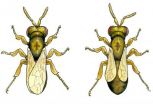(Press-News.org) In recent years, a number of controversial claims have been made about the female mammal's egg supply – that it is renewed over her adult lifetime (as opposed to the conventional understanding that she is born with all of her eggs), and that the source of these eggs is stem cells that originate in the bone marrow. Now, Weizmann Institute scientists have disproved one of those claims and pointed in new directions toward resolving the other. Their findings, based on an original method for reconstructing lineage trees for cells, were published online today in PLoS Genetics.
The method, developed over several years in the lab of Prof. Ehud Shapiro of the Institute's Biological Chemistry, and Computer Science and Applied Mathematics Departments, uses mutations in specific genetic markers to determine which cells are most closely related and how far back they share a common parent cell, to create a sort of family tree for cells. Shapiro and members of his lab, including Drs. Shalev Itzkovitz and Rivka Adar, together with Prof. Nava Dekel and research student Yitzhak Reizel of the Biological Regulation Department, used their method to see if ova could be descended from bone-marrow stem cells. Their findings indicated that any relationship between the two types was too distant for one to be an ancestor of the other.
These scientists also found, surprisingly, that the ova of older mice had undergone more cell divisions than those of younger mice. This could be the result of replenishment during adulthood, but an alternate theory holds that all eggs are created before birth, and those that undergo fewer divisions are simply selected earlier on for ovulation. Further experimentation, says Shapiro, will resolve the issue.
Cell lineage trees are similar to modern evolutionary and taxonomic trees based on genome comparisons between organisms. Shapiro and his team used mutations in cells that are passed on to daughter cells over an organism's lifetime (though not on to the next generation). By comparing a number of genetic sequences called microsatellites – areas where mutations occur like clockwork – they can place cells on trees to reveal their developmental history.
A number of papers published by Shapiro, his team and collaborators in recent months have demonstrated the power and versatility of this method. One study, for instance, lent support to the notion that the adult stem cells residing in tiny crypts in the lining of the colon do not harbor, as thought, "immortal DNA strands." Immortal strands may be retained by dividing stem cells if they always relegate the newly-synthesized DNA to the differentiating daughter cell and keep the original stand in the one that remains a stem cell.
A second study addressed an open question about developing muscle cells. Here they found that two kinds of progenitor cell - myogenic cells, which eventually give rise to muscle fiber, and non-myogenic cells – found within the same muscle are more closely related than similar cells in different muscles.
One immediate advantage of the cell lineage analysis method developed by Shapiro's team is that it is non-invasive and retrospective, and as such can be applied to the study of human cell lineages. Most other studies of development rely on genetically engineered lab animals in which the stem cells are tagged with fluorescent markers. In addition to providing a powerful new research method that does not rely on such markers, Shapiro believes that it could one day be adapted as a diagnostic tool that might, for instance, reveal the history of an individual's cancer and help doctors determine the best course of treatment.
INFORMATION:
Also participating in this research were Noa Chapla-Ilani, Adrian Jinich and Drs. Elad Segev, Eran Segal and Yosef Maruvka, of the Computer Science and Applied Mathematics Department, Zipora Marx, Inna Horovitz and Adam Wasserstrom of the Biological Chemistry Department, Drs. Judith Elbaz and Nava Nevo of the Biological Regulation Department, Dr. Avi Mayo of the Molecular Cell Biology Department, Drs. Gabi Shefer, Irena Shur and Prof. Dafna Benayahu of Tel Aviv University and Prof. Karl Skorecki of the Technion and Rambam Medical Center, Haifa.
Prof. Ehud Shapiro's research is supported by the Paul Sparr Foundation; Miel de Botton Aynsley, UK; the Carolito Stiftung; and the European Research Council. Prof. Shapiro is the incumbent of the Harry Weinrebe Professorial Chair of Computer Science and Biology.
Prof. Nava Dekel's research is supported by the Phyllis and Joseph Gurwin Fund for Scientific Advancement; the Jeanne and Joseph Nissim Foundation for Life Sciences Research; the M.D. Moross Institute for Cancer Research; the Y. Leon Benoziyo Institute for Molecular Medicine; the Yeda-Sela Center for Basic Research; the Willner Family Center for Vascular Biology, which she heads; the Dwek Family Biomedical Research Fund; the J&R Foundation; La Fondation Raphael et Regina Levy; the estate of John Hunter; and Allyson Kaye, UK. Prof. Dekel is the incumbent of the Philip M. Klutznick Professorial Chair of Developmental Biology.
Dr. Eran Segal's research is supported by the Cecil and Hilda Lewis Charitable Trust; the Carolito Stiftung; the Kahn Family Research Center for Systems Biology of the Human Cell; and the European Research Council.
The Weizmann Institute of Science in Rehovot, Israel, is one of the world's top-ranking multidisciplinary research institutions. Noted for its wide-ranging exploration of the natural and exact sciences, the Institute is home to 2,700 scientists, students, technicians and supporting staff. Institute research efforts include the search for new ways of fighting disease and hunger, examining leading questions in mathematics and computer science, probing the physics of matter and the universe, creating novel materials and developing new strategies for protecting the environment.
Weizmann Institute news releases are posted on the World Wide Web at http://wis-wander.weizmann.ac.il/, and are also available at http://www.eurekalert.org/
END
Scientists have discovered a new target in their fight against the devastating global disease 'malaria' thanks to the discovery of a new protein involved in the parasite's life cycle.
The research has uncovered a vital player in the sexual phase of the malaria parasite's reproduction which could prove an effective target for new treatments to stop the disease in its tracks.
The scientists from The University of Nottingham's School of Biology, with collaborators from the Universities of Leicester, Oxford, Imperial College London and Leiden in the Netherlands, have just ...
CHICAGO --- Millions of "good" bacteria exist harmoniously on the skin and in the intestines of healthy people. When harmful bacteria attack, the immune system fights back by sending out white blood cells to destroy the disease-causing interlopers. But how do white blood cells know which bacteria are good and which are harmful?
Northwestern University Feinberg School of Medicine researchers studied one type of white blood cell known as a macrophage, which is among the immune system's first to detect and eliminate harmful bacteria. The research team, led by Christian ...
Numerous mouse strains show great biological variation in features such as behavior, coat color and susceptibility to cancer and other diseases.
This study examines one possible genetic cause for differential gene expression and biological variation.
COLUMBUS, Ohio – The many short pieces of mobile DNA that exist in the genome can contribute to significant biological differences between lineages of mice, according to a new study led by researchers at the Ohio State University Comprehensive Cancer Center – Arthur G. James Cancer Hospital and Richard J. Solove Research ...
How we move is an excellent indicator of overall health. When we feel good, we move around continually. When we're in pain, we reduce our physical activity. This observation might seem trivial, but it has led to an original approach for evaluating chronic pain. A team from EPFL's Laboratory of Movement Analysis and Measurement (LMAM) has developed a clever, easy-to-use visual tool to help doctors assess their patients' pain levels. The research appears online February 23 in the journal PLoS One.
"Movement is an objective indicator of pain. You move differently if you're ...
The tiny, little-noticed jewel wasp may provide some answers as to how different species differ in size and shape. And that could lead to a better understanding of cell growth regulation, as well as the underlying causes of some diseases.
Using the wings of these insects as a tool to study how growth is regulated, biologists at the University of Rochester have discovered that changes in expression of a well-known cell regulator gene called "unpaired" (upd) accounts for wing growth differences between males of closely related species. Unpaired is distantly related to ...
Researchers at National Jewish Health have discovered specific molecular and signaling events by which vitamin D inhibits inflammation. In their experiments, they showed that low levels of Vitamin D, comparable to levels found in millions of people, failed to inhibit the inflammatory cascade, while levels considered adequate did inhibit inflammatory signaling. They reported their results in the March 1, 2011, issue of The Journal of Immunology.
"This study goes beyond previous associations of vitamin D with various health outcomes. It outlines a clear chain of cellular ...
A major register study from the Swedish medical university Karolinska Institutet shows that children born to certain groups of immigrants in Sweden had an increased risk of developing autism with intellectual disability. The study includes all children in Stockholm County from 2001 to 2007, and brings the question of the heredity of autism to the fore.
"This is an intriguing discovery, in which we can see strong links between a certain kind of autism and the time of the mother's immigration to Sweden," says principal investigator Cecilia Magnusson, Associate Professor ...
Prof. Dr. Albert Newen and Dr. Leon de Bruin from the Institute of Philosophy II at the Ruhr-Universität explain their theory in the journal Cognition. In the first year of life, children already have a basic "theory of mind", that is, they are capable of distinguishing their own beliefs from those of others. At the age of four, this capacity is fully developed. According to the Bochum model, this development is guided by two interacting systems.
Contradictory results: "false belief" test with and without language
The test: Sally puts her ball into a basket and goes ...
Some Parkinson's Disease patients can suddenly become creative when they take dopamine therapy, producing pictures, sculptures, novels and poetry. But their new-found interests can become so overwhelming that they ignore other aspects of their everyday life, such as daily chores and social activities, according to research published in the March issue of the European Journal of Neurology.
Italian researchers studied 36 patients with Parkinson's Disease - 18 with increased artistic production and 18 without - and compared them with 36 healthy controls without Parkinson's. ...
To connect a laptop to an additional monitor, projector or even to a monitor wall, a special cable was required, until now. Researchers of the Saarland University's Intel Visual Computing Institute overcome this obstacle by linking computer and monitor via an 'Internet Service'. By this means, a screen's contents can be shifted freely to any terminal's display and even shown on large-scale monitor walls. The Saarland University's scientists present their results for the first time at stand F34, in hall 9 at the computer fair Cebit. The trade show takes place in Hannover ...

